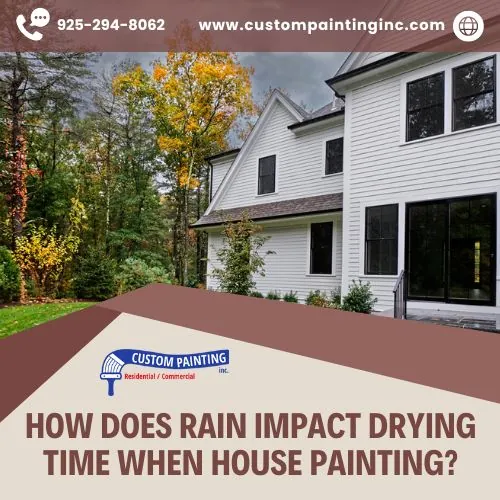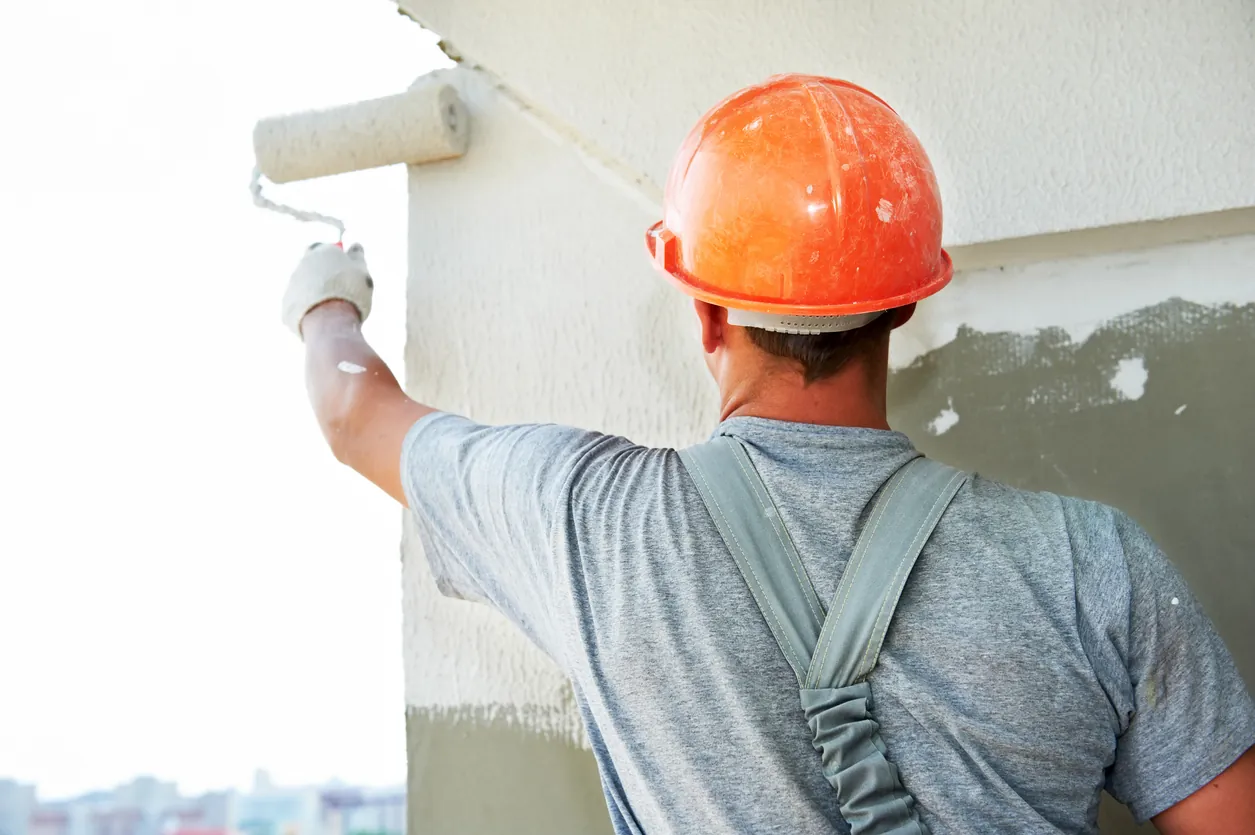Rain is a significant barrier to outdoor painting – especially exterior painting. It halts the painting process until it clears.
Even if it stops raining, you cannot go outside to paint immediately while the surface is still damp. Wait until the surface is completely dry before painting. You’ll avoid problems with paint drying and curing due to dampness. Even professional painters know that.
How Does Rain Affect Paint Drying Time?
Rain significantly impacts the drying time of house paint and can lead to several issues if painting occurs under wet conditions. Here are some key points to consider:
- Extended drying time – Rain increases humidity, which slows down the evaporation of water or solvents from the paint. It extends the drying time, potentially causing the paint to remain tacky for an extended period.
- Surface wetness – If the surface you paint is wet, the paint may not adhere properly. It can result in uneven application, blistering, or peeling of the paint once it dries.
- Running and streaking – Freshly applied paint can run or streak if it gets wet from rain. This not only affects the appearance, which calls for repainting.
- Primer and undercoats – Rain can also affect the underlying coats of primer or paint. If these layers do not dry properly, the topcoat may not adhere well, reducing the longevity and durability of the paint job.
- Water-based paints – Water-based paints, such as latex and acrylic, are popular for their ease of use and environmental benefits. But since they’re water-based, they’re particularly susceptible to rain. It can dilute the paints while wet, affecting their adhesive abilities, color, texture, and coat uniformity.
- Temperature considerations – Rain usually brings cooler temperatures, further slowing the drying process. Most paints require a specific temperature range to dry properly.
- Humidity – Rain often brings higher humidity, affecting paint application and adhesion. The paint reacts differently under varying humidity, hindering the chemical processes needed for the paint to dry and cure properly.
- Scheduling delays – Rain’s unpredictability can cause significant delays in exterior painting projects. You must delay starting the project before it starts to rain. Sometimes, it suddenly rains while you’re in the middle of the project, causing you to put off work and wait until the weather clears up. But again, even if it stops raining, you cannot resume until the surfaces are dry inside out. It leads to prolonged project times and potential inconvenience.
Due to these challenges, plan your paint projects with close attention to weather forecasts and use appropriate techniques and materials for the conditions. Preparing surfaces thoroughly, choosing the right type of paint, and applying it under favorable weather conditions can help mitigate the rain’s challenges.
Can You Still Paint on a Rainy Day?
Painting the exterior of a building on a rainy day is generally not recommended. Here are some reasons why:
- Paint quality – Rain can wash away fresh paint, causing streaks and uneven application. This can result in a poor finish that may need to be redone.
- Drying time – Paint needs a certain amount of time to dry properly, and moisture from rain can significantly extend drying times. This can lead to longer project completion times and potential issues with the paint’s adhesion abilities.
- Surface preparation – Exterior surfaces need to be dry before painting. Painting over wet surfaces can prevent the paint from adhering properly, leading to peeling and flaking in the future.
- Safety concerns – Wet surfaces can be slippery and hazardous, posing safety risks for painters working on ladders or scaffolding.
It’s best to wait for dry weather to ensure a high-quality, long-lasting paint job. If rain is expected, it’s advisable to postpone the painting until conditions improve.
Best Practices to Mitigate Rain’s Impact
- Check the weather forecast: Ensure no rain is expected for at least 24-48 hours after painting.
- Use quick-drying paints: Consider using paints formulated for quick drying to minimize the risk of rain damage.
- Protect the area: If rain is unexpected, use tarps or plastic sheeting to protect the freshly painted areas.
- Wait for optimal conditions: It is often best to wait for dry, warm, and breezy conditions to ensure the best results for your painting project.
How Soon Can You Paint After the Rain?
The answer depends on how damp the surface is. Once again, even after the rain, the surface is still a little wet to the touch; therefore, you cannot paint over it right away. You must wait until the surface is completely dry.
The general recommendation is to wait 24 to 48 hours after the rain before you can paint your home’s exterior. However, the drying time can vary depending on specific factors, such as the type of siding material you’ll paint, temperature, humidity levels, and ventilation (for interior painting). It can take shorter or longer than the recommended times.
Here are a few tips to determine whether it’s okay to paint outside after the rain:
- Check the surface — Certain materials, like wood, may absorb more moisture and take longer to dry than others. Touch the surface to ensure it feels dry to the touch.
- Consider humidity and temperature – High humidity can prolong the drying time of the surfaces and paint. Painting conditions are considered ideal with the humidity between 40% and 70% and temperatures between 50°F and 85°F (10°C to 29°C).
- Check the weather forecast – Look ahead to ensure no imminent rain showers could affect the newly applied paint. Also, give the paint enough time to cure before any potential rain per the manufacturer’s recommendations. Always refer to the paint manufacturer’s instructions for specific recommendations regarding drying times and conditions for painting.
- Use moisture meters – Use a moisture meter to ensure the moisture content is within the acceptable range for painting.
- Ensure paints match the surfaces – Here’s an example: wood siding accepts acrylics if it is dry to the touch. What’s important is that the surface you’ll paint is completely dry and ready to receive paint.
Conclusion
While it is impossible to counter the forces of nature, at least we can learn how to deal with them. Consider these tips and suggestions mentioned earlier. You won’t have to worry if the painting project doesn’t start at a scheduled time or if you’re forced to put off work in the middle of the project due to inclement weather.
Working with the experienced team from Custom Painting, Inc., you can rest easy knowing that the paint job will turn out exactly as you wanted. To learn about our interior and exterior residential paint services, call us at 925-294-8062 or complete our online form to schedule a free estimate.


